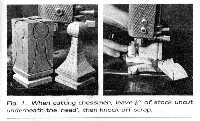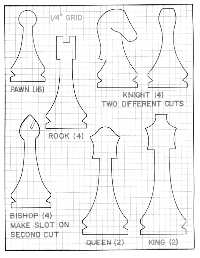|
Chess
and Checkers
Hands
On May/June 80
 It's
an exciting game to play, and an elegant game to look at. Chess
is played with six different pieces – king, queen, bishop, knight,
rook, and pawn – each piece a tiny sculpture. Most chess sets are
turned on a lathe or carved by hand; however, the set pictured here
is made on a Bandsaw, each piece formed with a compound cut. It's
an exciting game to play, and an elegant game to look at. Chess
is played with six different pieces – king, queen, bishop, knight,
rook, and pawn – each piece a tiny sculpture. Most chess sets are
turned on a lathe or carved by hand; however, the set pictured here
is made on a Bandsaw, each piece formed with a compound cut.
Making
Compound Cuts
The
technique of making compound cuts was explained in HANDS ON! No.
1, but here's a quick review:
Make your first cut or cuts.
-
Tape
the cut pieces back together.
-
Turn
the workpiece 90 degrees and cut again.
-
When
you unwrap the tape, you'll have a three-dimensional wooden
shape of an animal, candle-holder, or chess piece, depending
on the cuts you've made. It's a simple technique, but we suggest
that for this project you modify step #2 to make it even simpler.
Instead
of taping the pieces back together, leave about 1/8" of stock uncut
underneath the 'head' of each chessman. This will keep the scrap
attached with no need to tape it back on.
When
you've made all your cuts, go back and saw the remaining 1/8" segments,
knocking off the scrap. Only when making your last 1/8" cut will
you need any of that scrap, and then you still don't have to tape
it back on. Just set the chessman on top to make the cut square
with the blade. (See Fig. 1)

Fig.
1. When cutting chessmen, leave 1/8" of stock uncut underneath
the 'head', then Knock off scrap.
This modification of the compound cuts technique works well for
most small workpieces, saving a great deal of time and tape.
Making
the Chessmen
Select
two contrasting woods to distinguish one side of the chess set from
the other. We chose to make our set from walnut and maple.
Cut
your wood into small blocks before starting on the compound cuts.
Listed below are the number and size of blocks you’ll need:
16
Pawns 1-1/2" x 1-1/2" x 3-1/4"
4 Knights 1-3/4" x 1-3/4" x 3-1/2"
8 Rooks & Bishops 1-3/4" x 1-3/4" x 4-1/4"
2 Queens 2" x 2" x 4-3/4"
2 Kings 2" x 2" x 5-3/8"
The
kings, queens, rooks, and pawns are shaped with two cuts, each exactly
the same as the other. So are the bishops, but on the second cut
put a kerf in the heads to make the bishop's miter. The knights
are made with two different cuts to form the traditional horses'
heads. You may want to round their noses slightly to make them appear
more horse-like.
Checkers,
Too
If
you want to add checkers to your chess set, cut or glue up two blocks
1-3/4" x 1-3/4" x 12", each block made from one of your contrasting
woods. Turn the blocks on your Mark V to form two cylinders 1-3/4"
in diameter. Using the stop rod and the miter gauge, cut 12 checkers
from each cylinder on the Bandsaw, each checker 3/4" wide.
Finishing
the Pieces
The
shapes of the various chessmen are fairly intricate, and this unfortunately
makes them tedious to sand. However, we ran across a set of small
drum sanders that speed things up considerably. The drums reach
into most of the curves and crevices, and the chess pieces require
only touch-up hand sanding. If you decide that you'd rather sand
the chess set by hand, a small half-round rasp and a supply of emery
boards will prove useful.
We
also tried something new when applying a finish to the pieces hand-rubbed
polyurethane. Dip your chessmen and checkers in a can of high-gloss
polyurethane wood finish. Wipe off the excess with a rag and let
dry on a sheet of wax paper. Dip the pieces again and wait for the
finish to get tacky (about 10-15 minutes). Rub the partially dried
finish into the wood with a rag. Don't worry if this rag becomes
gummed up; this actually helps buff the finish. Let the pieces stand
overnight toharden completely.
Rubbing
the gummy polyurethane into the wood fills any mill marks and surface
imperfections. The wood becomes glass smooth and takes on a soft
glow. After the second coat, the polyurethane looks remarkably like
a hand-rubbed oil finish with only a fraction of the hand-rubbing.
It will also resist grease and grime (caused by the constant handling
of the chessmen and checkers) better than oil.
Finally,
glue squares and circles of felt to the underside of the chessmen
and checkers to protect the board they will rest on. And that's
it except for finding yourself a chess partner to help break the
set in.

|